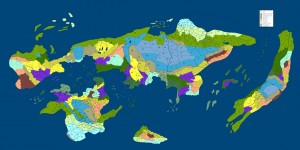Worldbuilding comes in three flavors, in my opinion: Top Down, Bottom Up and Concept Out. Top Down is, for example, deciding that the world of your story is going to be a fantastical, secondary-world version of medieval Arabia or revolutionary France, and working from that downward. Concept Out is taking a Big Idea– let’s say, Dragon People at war with Tree Folk– and building everything out from that. Bottom Up is taking the physical fundamentals: biomes, climate, flora and fauna, and finding the culture that could emerge from there, growing it over time.
All of these have their problems. Top Down runs the risk of reading like “X With The Serial Numbers Filed Off”. Concept Out may create a world that only has one story in it. Bottom Up requires a great deal of work just to get to the point where stories could be found.
 I started a Bottom-Up build, mostly as an intellectual exercise. I did it to figure out more about Worldbuilding. And, frankly, I felt I learned a lot in the process. Which then let me go back to all the worldbuilding and map work I had done for Maradaine, and ask myself, “What can I do better?”
I started a Bottom-Up build, mostly as an intellectual exercise. I did it to figure out more about Worldbuilding. And, frankly, I felt I learned a lot in the process. Which then let me go back to all the worldbuilding and map work I had done for Maradaine, and ask myself, “What can I do better?”
Maradaine’s worldbuild, in all honesty, started over 20 years ago, and started in a very top-down way. Map drawn, nations named, an then a one-sentence, high-concept, “This is what this country is.” It’s grown exponentially from that, but there is still so much more that can be done. But now I know so much more about worldbuilding. I didn’t know, for example, about Fertile Centers of Origin when I started that, or how it could help define a culture. But I know it now, and that helps create a richer, fuller world.
The funny thing about that is on some level, I don’t need to do it. The city-centric focus of the Maradaine books means that I don’t necessarily have to expand out the details beyond the city walls. I don’t have to know the regional distinctions of a country half a world away, or the history of how it went from bronze-age city-states to modern nation.
I don’t need to know it, but knowing adds depth and richness. Knowing means that if, say, I need to bring in an ancient artifact from a foreign or bit of historical background, I have it at my fingertips. Kaiana can quote a scene from the play Queen Mara because I already know the who’s, the what’s and when’s of Queen Mara. Someone can mention off hand that the Third War of the Tongues happened in the Second Vitali Dynasty of the Kieran Empire because I already know the whole history of the Kieran Empire and how many Wars of the Tongues there were and what dynasty was when. I can dig into the multiculturalism within the city– as I do in both An Import of Intrigue and Holver Alley Crew— because I not only know where and what Lyrana and Ch’omikTaa are, but the different historical reasons about why someone from those countries would be in Maradaine, and how that affects them today. Or even why, linguistically, Ch’omikTaa has an apostrophe and capital T.*
This is all to say, no matter where one started with the worldbuild, and no matter how much you think you have, there is room for more depth, and room to bring in the tools of other processes to improve upon the work you’ve done. I know I always want to do more, and do it better. And just because I’ve already published stories in the world, it’s far from meaning that the world is done. It keeps growing and changing.
—
*- Glottal stop and retroflex stop, respectively.
